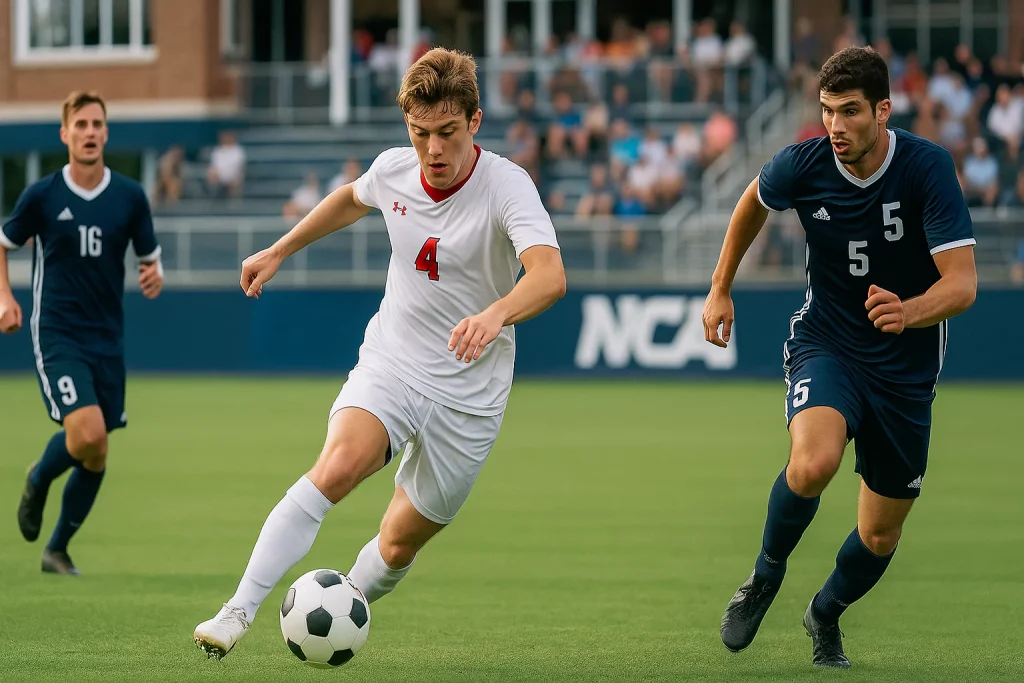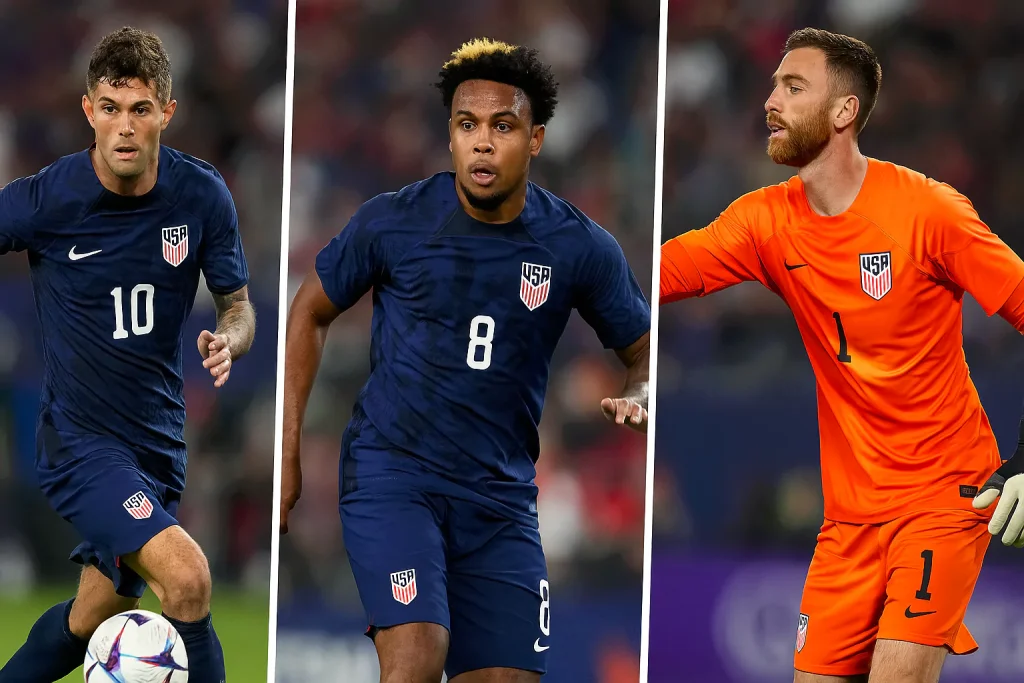Making it onto the U.S. National Soccer Team isn’t just about talent—it’s about timing, training, and knowing how the system works. When I was first diving into the youth soccer scene, I had no idea how complex the pathway really was. Over time, through interviews with coaches, scouts, and players who’ve worn the U.S. jersey, I’ve come to understand the full journey—and I’m here to walk you through it.
Whether you’re a young player chasing a dream, a parent looking for guidance, or a coach helping shape the next star, this guide will help you understand every step of how to be on the U.S. National Soccer Team.
We’ll explore the entire player pathway—from kicking a ball around at age 6 to competing on the international stage. I’ll break down what programs to join (like MLS Next or ODP), how scouting really works, and what coaches are actually looking for when they’re picking players for national duty.
This isn’t just theory—I’ll also share real examples, expert insights, and tips I’ve picked up from people deep in the game.
And if you’re wondering where to start or what’s realistic for your age and skill level, don’t worry—I’ve included tables that will help you understand which routes apply to you right now.
Understanding the Structure of US Soccer
Before you start chasing a national team spot, you need to understand how soccer is structured in the U.S. It’s different from what you might see in Europe or South America. Over here, the system is layered, and knowing where you fit can help you make smarter choices.
At the top is the U.S. Soccer Federation (USSF). It governs everything—from grassroots youth programs to the senior national teams. Under that umbrella, several key development pathways help players grow and get noticed.
Youth Systems: ODP, MLS NEXT, and Beyond
Youth soccer in the U.S. has gone through a lot of changes. The old U.S. Soccer Development Academy (DA) closed in 2020, and in its place, MLS NEXT became the go-to for top youth players. It’s run by Major League Soccer and is designed to develop elite-level talent.
Then there’s the Olympic Development Program (ODP), which identifies and trains top youth players across each state. It’s not as prestigious as MLS NEXT today, but it still serves as a solid option—especially for players outside big markets.
College and Professional Pathways
If you’re in high school and aiming for a national team spot, don’t ignore the NCAA route. Playing college soccer helps players stay in the game while getting a degree. Many U.S. National Team players like Matt Turner and Walker Zimmerman took this path before turning pro.
From there, some get drafted into MLS or sign with clubs in Europe. The stronger your college performance, the better your chances of getting invited to U.S. Soccer ID camps or even youth national team camps.
Contents
Steps to Get Noticed
Getting noticed by U.S. Soccer isn’t just luck. It’s a mix of preparation, performance, and playing in the right places. Here’s how to give yourself the best shot.
1. Start Young and Train Consistently
It all starts early. Most national-level players begin training seriously around age 8 or 9. But don’t worry if you’re starting a bit later—what matters is consistency.
Train every day, even if it’s just 30 minutes in your backyard. Focus on things like:
- Ball control
- First touch
- Dribbling in tight spaces
- Weak foot work
If you can, work with a coach or join a local skills academy. And don’t overlook fitness. Speed and endurance are huge in national-level soccer.
2. Join Competitive Clubs
If you want to be seen, you’ve got to be where the scouts are looking. That means joining top-tier clubs. Ideally, you want to be in MLS NEXT, but if that’s not possible, look for clubs in ECNL (Elite Clubs National League) or National League Pro.
The key is playing against top competition. That’s how you test your level and grow fast. Coaches and scouts pay close attention to these leagues, especially during major tournaments and playoffs.
Overview of Pathways to the US National Team
| Pathway | Age Range | Key Organizations | Success Rate |
| ODP | 12–17 | US Youth Soccer | Medium |
| MLS NEXT | 13–19 | Major League Soccer | High |
| College Soccer | 18–22 | NCAA, NAIA | Medium |
| Overseas Academies | 15–22 | European and Global Clubs | Low to Medium |
Note: Success rate refers to how often players from each pathway end up on youth or senior national teams.
3. Participate in High-Profile Tournaments and Showcases
Tournaments are where scouts take notes. If you’re playing in the Generation Adidas Cup, Dallas Cup, or the MLS NEXT Fest, you’re already on the radar.
Make sure to:
- Keep a highlight reel
- Record your best games
- Talk to college and national scouts when possible
Even a standout moment in one game can be the thing that gets you a callback.
4. Get Involved with the Olympic Development Program (ODP)
ODP still holds weight in many states. It may not be the top-tier path anymore, but it offers regional and national team exposure, and it’s often a stepping stone to ID camps.
Here’s how it works:
- Try out for your state ODP team
- If selected, you may advance to regional camps
- Regional players can be called into U.S. Youth National Team camps
For some, it’s a second chance to be seen if they’re not in the MLS system.
Excel in School and College Soccer
If you’re not in an MLS academy, school and college soccer can still be your bridge to the national team. I’ve seen players rise through the ranks simply by dominating in high school and earning a spot at a strong college program.
Why Academics Matter Too
National scouts are looking for well-rounded athletes. That includes good grades. College coaches want players who can stay eligible and balanced. So your GPA counts just as much as your goals.
To compete in college soccer, you’ll need to meet academic standards set by the NCAA Eligibility Center. For NAIA schools, it’s the NAIA Eligibility Center.
How College Soccer Fits the National Team Pathway
The college game is fast, physical, and tactical. It prepares you for higher-level play. Players like Matt Turner (Arsenal and USMNT goalkeeper) and DeAndre Yedlin both came through college systems.
Scouts often attend major college matches, especially during the NCAA Tournament. Playing well on this stage can earn you an invite to a U.S. Soccer youth or senior camp.
And remember: if you don’t go pro right away, playing in college gives you more time to develop.

Attend US Soccer ID Camps
ID camps are one of the most direct ways to get seen by national team scouts. I always recommend players treat these like job interviews—because that’s exactly what they are.
What Are ID Camps?
U.S. Soccer Talent Identification (ID) Camps are invite-only events where selected players train and compete under the eyes of national coaches. These aren’t regular camps—they’re advanced and highly competitive.
How to Get Invited
There’s no open registration. You get invited based on performance at:
- MLS NEXT and ECNL games
- ODP regional events
- College or high school matches
- National tournaments
Some players also get noticed through highlight reels or recommendations from club coaches.
Once you’re invited, show up ready. I’ve talked to scouts who said first impressions matter. Be vocal, stay sharp, and don’t try to do too much—just play your game at a high level.
What Coaches Look For
Coaches at ID camps are watching everything—your touches, your attitude, your positioning. They’re not just looking for raw talent. They want to see if you understand the game, adapt quickly, and play well with others.
Tips to Improve Your Chances
No matter where you’re starting from, there are always ways to level up. These tips are things I’ve seen consistently work across different levels of the game.
Train with Purpose
Don’t just go through the motions. Every session should have a focus—whether it’s dribbling under pressure, improving your shot placement, or learning to read the game better.
Watch the Game
Study how top players move, especially those who play your position. Watching USMNT games, Premier League, or Champions League matches can teach you more than a textbook.
Work on Mental Toughness
The road to the national team isn’t smooth. You’ll face rejection, injuries, and tough competition. Keep your head up and bounce back stronger.
Build a Highlight Reel
Record your games. Edit 2–4 minutes of your best plays and share them with coaches. It’s one of the easiest ways to get on a scout’s radar—especially if you’re in a smaller market.
Stay Coachable
Scouts love players who listen and learn fast. If you get feedback, apply it. If you mess up, recover quickly and stay focused. That kind of attitude goes a long way.
Skills and Attributes Coaches Look For
| Skill/Attribute | Why It Matters |
| Ball Control | Helps you stay calm under pressure |
| Vision & Awareness | Leads to smarter passes and better positioning |
| Stamina & Fitness | Keeps your level high for the full match |
| Coachability | Shows you’re willing to grow and adapt |
What Happens After Selection
So you’ve made it—either to a youth national team camp or the senior squad. Now what? This is where things get real. I’ve had the chance to speak with players and coaches who’ve gone through it, and they all say the same thing: it’s just the beginning.
Training Camps and Preparation
Once selected, you’ll be called into a U.S. Soccer national team training camp. These camps are intense. Players train daily, review film, and compete in intra-squad matches. It’s not just about skill—it’s about mindset, discipline, and understanding your role on the team.
The camps also serve as a way for coaches to see how you fit into the team’s tactics. Even if you’re not a starter, how you train and interact with others can affect your chances of staying in the system.
Friendly Matches and Tournaments
After camp, you might be picked for international friendlies or tournaments. At the youth level, this could be events like the Concacaf U-17 Championship or FIFA U-20 World Cup. At the senior level, you’re looking at World Cup Qualifiers, Nations League, or Gold Cup matches.
Travel is part of the experience. Players often fly across the world to represent the U.S., which is exciting but demanding. You’ll need to learn how to manage your body, rest properly, and stay focused even with jet lag.
Next Steps: Going Pro
Being selected for the national team can open doors. Many players use it as a launchpad to sign pro contracts, either in MLS or with teams overseas. If you’re still in college, you might be drafted or scouted directly.
For younger players, these camps put you on the radar of top agents, scouts, and clubs worldwide. Even if you don’t go pro right away, just being in the system boosts your credibility.
Real Player Success Stories (Optional Section)

I always find it helpful to look at real stories. These aren’t just stats on paper—these are players who made it from the same places many of us start. Their paths weren’t always smooth, but they show that it’s possible.
Christian Pulisic
Pulisic started playing in Pennsylvania and moved to the U.S. Soccer Development Academy system early on. By age 16, he was signed by Borussia Dortmund in Germany. From there, he rose quickly, making his U.S. Men’s National Team debut at just 17.
Now at AC Milan, he’s one of the most recognized American players in the world. His story shows how early exposure, smart development choices, and consistent performance can launch a global career.
Weston McKennie
McKennie didn’t follow the traditional path. He played for FC Dallas Academy but chose to sign with Schalke 04 in Germany instead of going to college. It was a bold move—but it paid off.
He’s since played for Juventus and now lines up alongside Pulisic at Milan. What stood out to scouts? His physicality, tactical discipline, and confidence. He’s a great example of trusting your gut and betting on yourself.
Matt Turner
Turner’s journey is the ultimate underdog story. He didn’t play academy soccer growing up. Instead, he walked on to the Fairfield University team and went undrafted in the MLS SuperDraft.
But he kept working. After signing with New England Revolution, he quickly became one of the league’s top goalkeepers. In 2021, he was named the Gold Cup’s Best Goalkeeper. Now he’s playing in the Premier League with Nottingham Forest.
These stories prove that there’s no one-size-fits-all path. Some players come from big clubs. Others rise from overlooked places. But they all share one thing: they never stopped improving, and they never gave up.
Common Challenges and How to Overcome Them
The journey to the U.S. National Soccer Team isn’t easy. I’ve seen talented players drop out, not because they weren’t good enough—but because they didn’t know how to handle the bumps along the way. Let’s talk about some of the biggest challenges and how to push through them.
Injuries
Injuries can happen at any level. They’re frustrating and can set you back. I’ve had friends who tore ACLs just as they were getting scouted. But recovery isn’t the end—it’s a test of your mindset.
If you get injured:
- See a qualified sports medicine doctor
- Stick to your rehab schedule
- Stay mentally involved—watch film, support your teammates, and study the game
Some players even come back stronger after recovery because they gain a better understanding of their bodies.
Burnout and Pressure
Chasing big goals comes with pressure. Between school, training, and trying to impress scouts, it can all pile up. I’ve felt it too—especially during showcase tournaments.
What helped me:
- Taking one day off a week to rest mentally
- Talking to teammates or a sports psychologist
- Focusing on my love for the game, not just the outcome
Remember, it’s okay to feel overwhelmed. The key is managing it before it takes over.
Lack of Access to Elite Clubs or Events
Not everyone lives near an MLS NEXT club or has money for high-level tournaments. That doesn’t mean you’re out of the game.
Here’s what you can do:
- Play well where you are—scouts notice standout players in local leagues too
- Build a solid highlight reel and send it to colleges or coaches
- Attend affordable ID camps or open tryouts when possible
It’s not always about where you start—it’s about how you grow.
Conclusion
If you’ve made it this far, you now know the full picture of how to be on the U.S. National Soccer Team. From youth clubs and school soccer to national ID camps and college showcases, every step matters.
I’ve seen firsthand that this path is possible—even for players who don’t start in elite programs. With the right mindset, consistent training, and smart choices, you can stand out. You don’t need to be perfect—you just need to stay ready and keep showing up.
Whether you’re just starting or already deep into your soccer journey, the most important thing is to stay hungry. Learn from every game, every coach, and every setback. That’s what separates good players from great ones.
So go out there, train smart, stay humble, and chase your dream. The next call-up could be yours.
FAQ Section
What age should I start if I want to make the U.S. National Team?
Most top players begin training seriously between ages 8–10. But even if you start later, you can still catch up with the right dedication and coaching.
Do I have to play for an MLS NEXT team to get scouted?
Not necessarily. While MLS NEXT is the top youth league, players from ECNL, ODP, and even local clubs have been called into national team camps.
Can I make the national team if I go to college instead of going pro early?
Yes. Many U.S. Men’s National Team players like Walker Zimmerman and Matt Turner played college soccer before turning pro.
How can I get invited to a U.S. Soccer ID camp?
You can’t sign up for these. Players are scouted and invited based on their performances in top youth leagues, tournaments, or referrals from coaches.
Is it possible to play for the U.S. if I wasn’t born here?
Yes. As long as you’re a U.S. citizen or have a parent who is, and you meet FIFA eligibility rules, you can play for the national team.
 Sports Daily Info All Things Sports, from News to Match Schedules
Sports Daily Info All Things Sports, from News to Match Schedules



